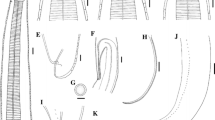Abstract
In order to evaluate the importance of cercarial chaetotaxy in the identification of European avian schistosomatids of the genus Trichobilharzia Skrjabin & Zakharow, 1920, papillary patterns of T. franki Müller & Kimmig, 1994 and T. ocellata (La Valette, 1855) Brumpt, 1931 were examined and compared. Scanning electron microscopy (SEM) was also employed to confirm the number and distribution of the sensory papillae. The chaetotaxy of T. franki and T. ocellata were identical, which suggests a close kinship between the two species. Some sensory papillae stained insufficiently with silver nitrate or were difficult to examine using light microscopy. Thus, the use of SEM in future examinations of Trichobilharzia chaetotaxy will ensure the collection of data that are comparable between studies, even though some argentophilic structures are not visible using SEM.
Similar content being viewed by others
References
Albaret, J.L., Bayssade-Dufour, C. & Ngendahayo, L.D. (1993) Identification of cercariae of African Schistosoma emitted by Bulinus umbilicatus, B.truncatus and B.forskalii. Systematic Parasitology, 26, 209–214.
Bayssade-Dufour, C. (1977a) Différences au niveau des sensilles entre les cercaires africaines et américaines de Schistosoma mansoni, agent de la bilharziose intestinale humaine. Comptes Rendus Hebdomaires des Séances de l'Academie des Sciences, Série D, Sciences Naturelles, 285, 191–193.
Bayssade-Dufour, C. (1977b) Variation chétotaxique chez les cer-caires de Schistosoma mansoni, agent de la bilharziose intesti-nale, en corrélation avec l'hôte vertébré de ce parasite. Comptes Rendus Hebdomaires des Séances de l'Academie des Sciences, Série D, Sciences Naturelles, 285, 1,511–1,513.
Bayssade-Dufour, C. (1979) L'appareil sensoriel des cercaires et la systématique des trématodes digénétiques. Mémoires du Museum National d'Histoire Naturelle, Série A, Zoologie, 113, 1–81.
Bayssade-Dufour, C. & Ow-Yang, C.K. (1975) The sensory re-ceptors of two cercariae from Malaysia: Trichobilharzia brevis (Schistosomatidae) and Haplorchis pumilio (Heterophysidae). Southeast Asian Journal of Tropical Medicine and Public Health, 6, 338–342.
Bayssade-Dufour, C., Cabaret, J., Ngendahayo, L.D., Albaret, J.L., Carrat, C. & Chabaud, A.G. (1989) Identification of Schisto-soma haematobium, S.bovis and S.curassoni by multivariate analysis of cercarial papillae indices. International Journal for Parasitology, 19, 839–846.
Blair, D. (1977) A key to cercariae of British strigeoids (Digenea) for which the life-cycles are known, and notes on the characters used. Journal of Helminthology, 51, 155–166.
Blair, D. & Islam, K.S. (1983) The life-cycle and morphology of Tri-chobilharzia australis n. sp. (Digenea: Schistosomatidae) from the nasal blood vessels of the black duck (Anas superciliosa)in Australia, with a review of the genus Trichobilharzia. Systematic Parasitology, 5, 89–117.
Cabaret, J., Bayssade-Dufour, C., Albaraet, J.L., Ngendahayo, L.D. & Chabaud, A.G. (1990) A technique for identification of cer-cariae of Schistosoma haematobium, S.curassoni, S.bovis and S.intercalatum. Annales de Parasitologie Humaine et Comparée, 65, 61–63.
Cort, W.W. (1950) Studies on schistosome dermatitis. XI. Status of knowledge after more than twenty years. American Journal of Hygiene, 52, 251–307.
de Gentile, L., Picot, H., Bourdeau, P., Kerjan, A., Piriou, M., Le Guennic, A., Bayssade-Dufour, C., Chabasse, D. & Mott, K.E.(1996) La dermatite cercarienne en Europe: un problème de santé publique nouveau?. Bulletin de l'Organisation Mondiale de la Santé, 74, 159–163.
Eklu-Natey, D.T., Al-Khudri, M., Gauthey, D., Dubois, J.P., Wüest, J., Vaucher, C. & Huggel, H. (1985) Epidémiologie de la dermatite des baigneurs et morphologie de Trichobilharzia cf. ocellata dans le lac Léman. Revue Suisse de Zoologie, 92, 939–953.
Farley, J. (1971) A review of the family Schistosomatidae: ex-cluding the genus Schistosoma from mammals. Journal of Helminthology, 45, 280–320.
Feiler, W. & Haas, W. (1988) Host finding in Trichobilharzia ocellata cercariae: swimming and attachment to the host. Par-asitology, 96, 493–505.
Grabda-Kazubska, B. & Moczon, T. (1981) Nervous system and chaetotaxy in the cercaria of Haplometra cylindracea (Zeder, 1800) (Digenea, Plagiorchiidae). Zeitschrift für Parasitenkunde, 65, 53–61.
Islam, K.S. (1986) The morphology and life-cycle of Trichobil-harzia arcuata n. sp. (Schistosomatidae: Bilharziellinae) a nasal schistosome of water whistle ducks (Dendrocygna arcuata)in Australia. Systematic Parasitology, 8, 117–128.
Islam, K.S. & Copeman, D.B. (1986) The morpholology and life-cycle of Trichobilharzia parocellata (Johnston & Simpson, 1939) Islam & Copeman, 1980 from the visceral blood vessels of Australian anatids. Systematic Parasitology, 8, 39–49.
Kalbe, M., Haberl, B. & Haas, W. (1997) Miracidial host-finding in Fasciola hepatica and Trichobilharzia ocellata is stimulated by species-specific glycoconjugates released from the snail hosts.Parasitology Research, 83, 806–812.
Kolarova, L. & Horak, P. (1996) Morphology and chaetotaxy of Trichobilharzia szidati Neuhaus, 1952 cercariae (Trematoda: Schistosomatidae: Bilharziellinae). Helminthologia, 33, 3–7.
Meyer, P.O. & Dubois, G. (1954) Dermatite humaine causée par des furcocercaires ocellés dans les bains publics de Zurich. Bulletin de la Société Neuchâteloise des Sciences Naturelles, 77, 81–110.
Mohandas, A. (1971) Integumentary papillae and their taxonomic importance in cercaria. Zeitschrift für Parasitenkunde, 35, 334–339.
Nassi, H. (1987) Sur quatre furcocercaires émises par Biomphalaria glabrata en Guadeloupe. Annales de Parasitologie Humaine et Comparée, 62, 17–35.
Niewiadomska, K. (1996) The genus Diplostomum – taxonomy, morphology and biology. Acta Parasitologica, 41, 55–66.
Niewiadomska, K. & Moczon, T. (1982) The nervous system of Diplostomum pseudospathaceum Niewiadomska, (Digenea, Diplostomatidae). Zeitschrift für Parasitenkunde, 68, 295–304.
Odening, K. (1996) What Cercaria ocellata actually is. Acta Para-sitologica Turcica, 20, 387–397.
Richard, J. (1971) La chétotaxie des cercaires valeur systématique et phylétique. Mémoires du Muséum National d'Histoire Naturelle, Série A, Zoologie, 67, 1–179.
Ross G.C., Bayssade-Dufour, C., Southgate, V.R., Albaret, J.L., Ngendahayo, L.D. & Chabaud, A.G. (1987) Relationships be-tween cercarial indices of Schistosoma haematobium, S.bovis, and S.curassoni from Senegal and the isoenzyme genotypes of the adult worms. Annales de Parasitologie Humaine et Com-parée, 62, 507–515.
Short, R.B. & Cartrett, M.L. (1973) Argentophilic "papillae" of Schistosoma mansoni cercariae. Journal of Parasitology, 59, 1,041–1,059.
Sweeting, R. (1976) An experimental demonstration of the life cycle of a Diplostomulum from Lampetra fluviatilis Linnaeus, 1758. Zeitschrift für Parasitenkunde, 49, 233–242.
van de Roemer, A. (1984) [Penetration of the cercaria of Trichobil-harzia ocellata.] PhD thesis, University of Frankfurt, Frankfurt, 90 pp. (In German).
Author information
Authors and Affiliations
Rights and permissions
About this article
Cite this article
Kock, S., Böckeler, W. Observations on cercarial chaetotaxy as a means for the identification of European species of Trichobilharzia Skrjabin & Zakharow, 1920 (Digenea: Schistosomatidae). Syst Parasitol 43, 159–166 (1999). https://doi.org/10.1023/A:1006118619762
Issue Date:
DOI: https://doi.org/10.1023/A:1006118619762




